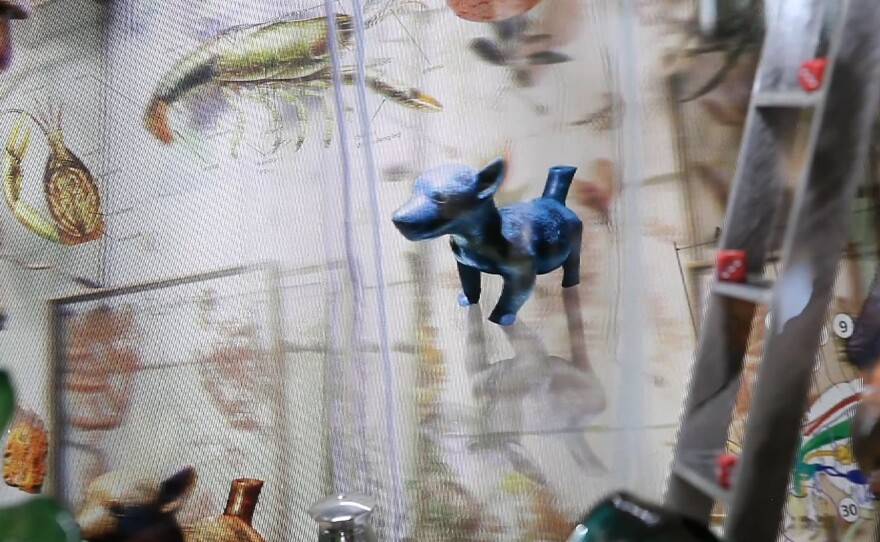A few weeks ago, I went to see how the de la Torre brothers were doing as they installed their latest public art piece. I found them, along with a few assistants, crammed into the central library’s elevator shaft.
Jamex, the older de la Torre brother by three years, climbed down from a ladder. "The site that we got in the elevator shaft, is a pretty sweet site for an artist," he said.
His brother Einar wore a black T-shirt with the Virgin of Guadalupe on it, his long hair hanging out from under his hard hat. He agreed the elevator makes for a great art gallery. "We have a captive audience if you will, which is kind of nice for art in general," Einar said.
The artists are known for their glass sculptures and installations. The word "ornate" doesn’t come close to describing the explosion of color and layering in their work.

For the library elevator, they’re installing two columns of diorama boxes (imagine really large aquariums with no water, but plenty of art). They’re stacked on top of one another, four to a column. As visitors take the glass elevator to the second floor, they’ll rise past the dioramas, each with different scenes inside.
The brothers were partly inspired by the dioramas in museums of Natural History — you know, the ones with taxidermy and painted backdrops depicting life on the Serengeti. They admire the craftmanship it takes to build those natural habitat dioramas. They also think it's an effective tool in focusing the viewer. "That idea of making a little world, a microcosm, is fascinating way to limit the viewers perspective and involve them in what you’re making," Einar explained.

And there’s plenty to get involved with in the de la Torre brothers' dioramas. They’re jam-packed, bearing the artists usual devotion to the baroque. There are references to Mexican, Aztec and Chicano culture, along with a healthy dose of pop culture in all of them. Each box is like a funhouse world; surreal and trippy.

Each of the eight boxes are lined with prints that create an illusion of depth, or 3D effect. They’re called lenticular prints and the artists started using them about two years ago. "It’s a visual trick that gives you this three-dimensional effect that is really quite effective. We always say that our work is layered like an onion and with this technology we can do that more and more in one piece of acrylic," Jamex de la Torre said.

Many of the boxes have busts of famous composers and historical figures. "We're trying to imply this kind of classicism with the bust. There’s a very western aesthetic involved in this and higher learning implied there," Einar explained. "We wanted to allude to it, but also bust that open." Not sure if this pun was intended, but there it is.
A clear resin bust of Napoleon (I think it's him) is filled with beads, shells and other bric-a-brac. A signature aspect of the brothers’ art is a mix of high and low art, the rarefied with the mundane.
The de la Torres were born in Guadalajara, Mexico, but grew up in Southern California. They maintain studios on both sides of the border - here in San Diego and south in Ensenada.
They were raised Catholic. Einar de la Torre said they’ve learned from Catholicism’s use of statues to tell stories visually.
"Through the Middle Ages, it was an illiterate population that needed to be told all of these stories so they have all these figures (statues) do that in churches," he explained.
The stories in the elevator dioramas are inspired by the library setting, but they aren't traditional stories with beginnings and endings. "We struggle with this because it seems so easy to make a linear thing about history and knowledge but we want it to be more fun and more entertaining," Jamex said.
The artwork is called "Corpus Callosum," after the part of the brain that makes connections between the left and right hemispheres. The brothers like the idea of putting random images and statues together to see what connections the viewer might make.
"I think we’re really intrigued with the idea of how discoveries happen," Einar added. Discoveries happen all the time in a library, they point out. People go to find one book, but discover other interesting books while there.
"And that’s kind of a cool thing about a library," Einar said. "You might find other things that you weren’t necessarily seeking and open yourself up to worlds you didn’t know were there."
In the new central library, those opportunities for discovery won’t only be in the stacks of books. They’ll be in the elevator as well.






